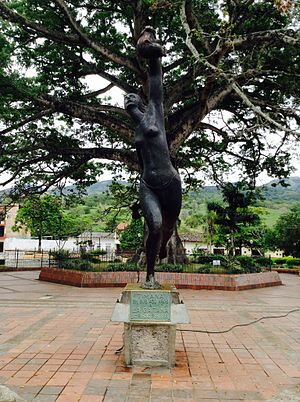La Gaitana (english version)
En otros idiomas| Nombre | Guaitipán |
|---|---|
| Fecha de nacimiento | First half of the 16th century |
| Nacionalidad | Yalcón - Colombiana |
| Seudónimo | La Gaitana |
| Ocupación | Cacica and warrior leader |
| País de nacimiento | Nueva Reino de Granada (Imperio Español) |
| Ciudad de nacimiento | Timaná, later known as Villa de la Gaitana in Huila, Colombia |
Guaitipan or “La Gaitana”, a chieftain of the Yalcón culture known by 16th century Spanish conquerors and chroniclers as “La Gaitana”, was the indigenous woman who resisted the colonization of her territory, initially bringing together more than six thousand indigenous people from different communities (initially Timanaes, Yalcones, and Pijaos) against the violent acts of domination of Pedro de Añasco and his men, who acted by order of the conqueror Sebastián de Belalcázar. A colonizing process of appropriation of land, property, and native labor force that led to the massacre of hundreds of indigenous people in the south of the country and the dispossession of lands and cultural forms of their survivors. Avenging her son, who had been burned alive by Añasco, Guaitipán, counterattacking with her sibling peoples, captured the murderer of her son alive and subjected him to a slow and painful death as revenge and derision for the Iberian colonizers. Over the years she continued to forge alliances, this time with the Aviramas, Paeces, and Guanacas of Tierradentro, achieving a warrior force of about 15 thousand men. Guatipán disappeared amid the Spanish onslaught to the indigenous uprising motivated by her. Her rebellion and warlike arts disrupted the Spanish settlement in the southern Colombian Andes for several decades, leaving a revolutionary legacy to the communities to fight the conquerors. Even today, La Gaitana is an indigenous symbol of resistance.
⧼banrepcultural-no-categories⧽
